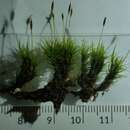Comprehensive Description
provided by North American Flora
Dicranum fulvum Hook. Musci Exot. pi. 149. 1820
Dicranum inlerruplum B. S. G. Bryol. Eur. (37-40:) Dicranum 30. 1847. Campylopus viridis Sull. & Lesq. Musci Bor.Am. 72. 1856. Dicranum viride Lindb. Hedwigia 2 : 70. 1863. Dicranum subfulvum Ren. & Card. Bot. Gaz. 22: 49. 1896. I Dicranum subsubulifolium Kindb. Rev. Bryol. 37: 13. 1910. i
Dioicous: male plants more slender than the fertile and mingled with them, bearing a number of rather large, scattered flowers, each with 10-12 antheridia about 0.4 mm. high and rather numerous paraphyses: fertile plants in greenish or yellowish-brown, often extensive mats, with tomentose stems up to 5 cm. high : stem-leaves 5-6 mm. long, spreading-flexuous all round, more or less crispate, or falcate-secund, long-lanceolate, gradually narrowed to a grooved point, often broken, mostly slightly serrulate toward the apex and smoothish to papillose on the back, the narrow blade above of a double thickness of cells; costa one third to one fourth the width of the leaf below, excurrent, often slightly serrulate on the back above, in cross-section below showing 14-20 guide-cells with stereid-bands above and below more or less interrupted by larger cells; alar cells brown to hyaline, extending to the costa, more or less auriculate; lower leaf-cells from elongate-rectangular to nearly square, with slightly thickened not pitted walls or rarely slightly pitted just above the alar cells near the costa; upper leaf -cells mostly square, sometimes short-rectangular with walls not pitted; inner perichaetial leaves with a convolute base 3-4 mm. high, abruptly or truncately narrowed with a sinuate or dentate margin to a slender subula, smooth or serrulate above and nearly as long as the basal part: seta solitary , yellow or finally turning reddish, up to 1.5 cm. high: capsule erect, cylindric, up to 3 mm.long, scarcely or not furrowed when dry; exothecal cells except near the mouth mostly elongate, very irregular, with slightly sinuous, unequally thickened walls; annulus of mostly 2 rows of cells; peristome-teeth red dishbrown, divided about one half down or often perforate below and the forks united above, the outer plates vertically or obliquely striate, sometimes nearly smooth; lid conic-subulate, about two thirds the length of the capsule: spores rough, up to 25" n in diameter.
Type locality: Nova Scotia.
Distribution: Nova Scotia to Georgia and westward to Minnesotaand Missouri; also in Europe and Asia.
- bibliographic citation
- Robert Statham Williams. 1913. (BRYALES); DICRANACEAE, LEUCOBRYACEAE. North American flora. vol 15(2). New York Botanical Garden, New York, NY

